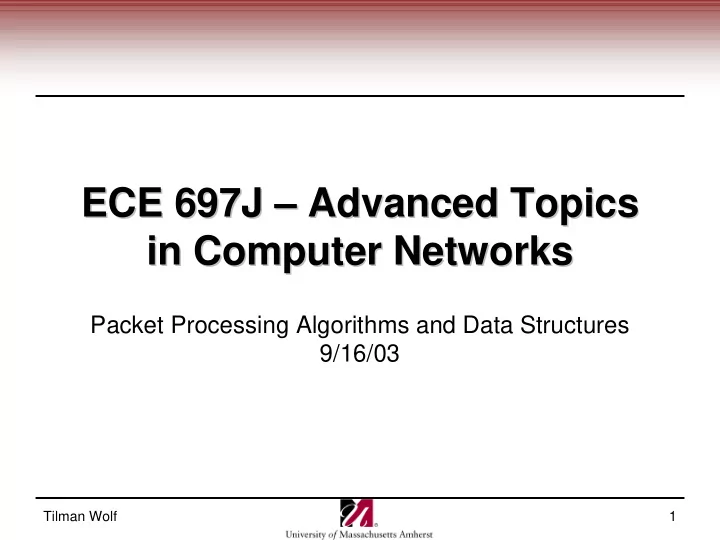

ECE 697J – – Advanced Topics Advanced Topics ECE 697J in Computer Networks in Computer Networks Packet Processing Algorithms and Data Structures 9/16/03 Tilman Wolf 1
Packet Processing Packet Processing • Software processing of packets • Issues: – System goals – Buffer management – Network byte order – Bridge algorithm – Table lookups and hashing – IP fragmentation and reassembly – IP forwarding – TCP connection recognition – TCP splicing Tilman Wolf 2
System Goals System Goals • “To allow it to run arbitrarily long, a network system must be designed with limits on all resources and the limits must be fixed independent of arriving traffic; designs that violate this principle will not be considered” • Examples? • Related statement: “Network systems should be designed to handle worst case traffic.” • How is this different from a general workstation? Tilman Wolf 3
Packet Buffers Packet Buffers • How many packet buffers should be available? – Many to avoid loss – Few to avoid delay • Variable-size buffer allocation can lead to fragmentation – Example? • Buffer copying is expensive – Why? – What can be done to reduce buffer copies? • What size should buffers be? – Max IP packet size is 64kB Tilman Wolf 4
Packet Sizes Packet Sizes • From caida.org: Tilman Wolf 5
Packet Sizes Packet Sizes • From caida.org: Tilman Wolf 6
Buffer Sizes Buffer Sizes • Many packets are very small • Almost no packets larger than 1500 bytes • Buffer allocation schemes: – Large buffer – Linked list • What are the pros and cons? • Example implementation of buffer mechanism: – “mbufs” in BSD Unix operating system Tilman Wolf 7
mbufs mbufs • Unix BSD packet mbufs: • Also allows for large buffer Tilman Wolf 8
Byte Order Byte Order • Networks connect to heterogeneous end-systems • Different end-systems implement things differently • Byte order: arrangement of bytes that make up word – Little endian: – Big endian: • Which systems implement what order? – Intel architecture: little endian – Network byte order: big endian Tilman Wolf 9
Byte Order Conversion Byte Order Conversion • Typical OS functions to adjust byte order: • This is a major source of programming errors! • Side note: What are other annoying system convention that cause interoperability problems? Tilman Wolf 10
Next Class Next Class • Ramu will present: – Packet classification – Scheduling – Read chapters 6 & 9 • Next Tuesday: – IP lookup paper (everybody read the paper!) – Protocol software on conventional processor (chapter 7) • Other issue: – Presentation evaluation form Tilman Wolf 11
Recommend
More recommend